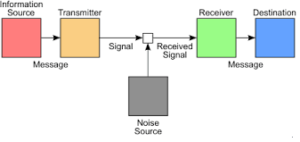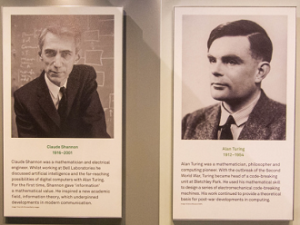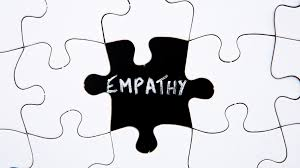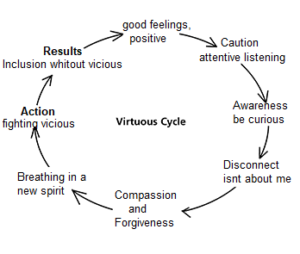
Arquivo para a ‘Cognition’ Categoria
Communication, Shannon and data
Born in the small town of Gaylord, Claude Shannon watched the creation of telegraphs using the barbed wire of the mountain farms in his region from an early age. He soon built his own telegraph, unlike the telephone companies of the time, in the countryside they continued to use barbed wire to send messages as telegraphs.
Shannon watched the creation of telegraphs using the barbed wire of the mountain farms in his region from an early age. He soon built his own telegraph, unlike the telephone companies of the time, in the countryside they continued to use barbed wire to send messages as telegraphs.
Shannon went to study at the University of Michigan, interested in mathematics and communication, where he discovered an advertisement asking for monitors for Vannevar Bush’s famous MIT Laboratory, where students finishing their theses were looking for a machine to tabulate data, unlike Charles Babbage’s historic English computer, this was just a machine to tabulate data, we could say a nascent data science.
The MIT laboratory was where “professors and students turned to the Differential Analyzer in moments of desperation, and when it was possible to solve equations with a margin of error of 2%, the operator of the Claude Shannon Machine was happy” (Gleick, 2013, p. 181).
The circuits of this machine were made up of ordinary switches and special switches called relays, direct descendants of the telegraph and predecessors of the logic of 0 and 1, whose logic was known to Bush, called Boole’s Algebra, which Shannon learned there.
This was where the data processed by Bush’s differential analyzer and the new logic of 0 and 1 came together, the other point we made in the previous post, the concern with an intelligible language for the machine and the problem of coding and decoding messages modified into electrical signals in the logic of 0 and 1.
Claude Shannon’s important point and great collaboration, expressed in his Mathematical Theory of Communication, determined how many coded signals would be needed to maintain the integrity of the message before the coding process.
The so-called Shannon Theorem determines that a number of signals twice the highest frequency communicated through the channel are required between the sender, who precedes the message sent, and the receiver, who decodes the signal and reconstructs the message. In order for this message to remain unchanged, the number of signals in Shannon’s Theorem must be observed.
The noise problem depends exclusively on the distance and the way the signal is captured and sampled (segmented into a quantity that complies with the theorem) while the sender and receiver problem depend on the transformation of the message into a signal (i.e. the transformation of an analog signal into a digital signal and vice versa).
The message sent and the message received depend only on human sources, as the sender and receiver are electrical, digital or photonic devices. Quantum devices are already being developed and could represent greater speed and signal integrity.
Gleick. (2013) Informação: uma história, uma teoria e uma enxurrada. (Information: a history, a theory and a flood). Trad. Augusto Cali. Brazil, São Paulo: ed. Companhia das Letras.
Thought and information technology
The origins of almost all realities (if we don’t consider the divine and eternal) come from human thought, the idea of politics in the Greek polis, the idea of the “art of war”, from the law codes of Hammurabi (1792 to 1750 BC) to modern contractualists, compilations of religious treatises, epistemological constructions of the sciences and computer science could not be left out.
consider the divine and eternal) come from human thought, the idea of politics in the Greek polis, the idea of the “art of war”, from the law codes of Hammurabi (1792 to 1750 BC) to modern contractualists, compilations of religious treatises, epistemological constructions of the sciences and computer science could not be left out.
In 1900, when physics and mathematics seemed to give an air of precision and certainty to the scientific universe, positivism still reigned in law, a German mathematician David Hilbert proposed 23 “final” problems for mathematics at an International Congress in Paris in 1900.
Among these was the second problem: the finitist solution to the consistency of the axioms of arithmetic, which together with the sixth problem, which was the axiomatization of physics, seemed to give a logical and precise finish to all of science, but there had already been a return to the question of Being through Husserl and Heidegger, and this returned thought to human complexity.
Kurt Gödel, a member of the Vienna Circle who eschewed this logic and for this reason was called a neologicist, proved the incompleteness of the second problem, that arithmetic was either consistent or complete, thus remaining in a paradox, called Gödel’s Paradox.
The question of arithmetic is important to understand the origin of the idea of algorithms, which were previously just formulas like Bhaskara’s formula (for 2nd degree equations), complex solutions to differential equations, while physics had the problem of formulating all of physics in a single theory, the so-called Standard Theory of Physics, but quantum mechanics and the theory of general relativity, where time and space are not absolute, changed this scenario.
The meeting of Claude Shannon and Alain Turing, who were working on secret projects to code transmissions (made for the Roosevelt government) and decode the Enigma machine captured from the Nazis (Turing’s secret project) will create a new event.
Unable to talk about their secret projects (Gleick, 2013, p. 213), they talked about Gödel’s paradox and wondered about the possibility of the machine elaborating thoughts, even if it was something limited, and both developed theories about language and algorithms.
While Turing devised a state machine that, through back and forth movements of a tape recording symbols, would produce intelligible sentences, Shannon worked on a similar model (using a theory called Markov chain) that, through finite vocabularies, could compose sentences and formulate broader ideas.
Alain Turing’s definitive contribution was the so-called Finite State Machine, whose model was completed by Alonzo Church, while Claude Shannon left the contribution of a Mathematical Theory for Communication, his theory establishing the amount necessary for the information transmitted not to be damaged, but within the limits of the “machine”.
The reductionist idea that it is possible to carry out actions without a necessary, elaborate, meditated and tested thought is part of current pseudo-scientific narratives.
Gleick. (2013) . Informação: uma história, uma teoria e uma enxurrada. (Information: a history, a theory and a flood). Transl. Augusto Cali. Brazil, São Paulo: Companhia das Letras.
Thinkers with full bellies
Modern society is characterized by an absence of serious developed thought. What is called “critical thinking” is nothing more than the rejection of any thinker who tries to think outside the ideological bubble, or of vulgar and superficial narratives.
of serious developed thought. What is called “critical thinking” is nothing more than the rejection of any thinker who tries to think outside the ideological bubble, or of vulgar and superficial narratives.
They don’t know about the great classical works, even those professed by Kant, Hegel or Marx, deep literature by Zolá, Vitor Hugo, Proust, Balzac, Camus or more current ones like George Orwell, James Joyce, Gabriel Garcia Marques or Jorge Luís Borges, Eurocentric in their shallow knowledge, preferring the contentless criticism of thinkers who challenge all current thinking as fragmentary: Heidegger, Gadamer, Peter Sloterdijk and Byung-Chul Han.
Their bellies are full of food that fills their stomachs, but it’s far from being the kind of food that provides a deep and well-founded critique of current thinking: decadent sociologism, little meditation (read Hannah Arent or Byung-Chul Han on the Vita Contemplativa) and little knowledge of even the late Enlightenment that they profess.
At most, they know Bauman’s liquid and Eurocentric thinking, Foucault’s biopolitics or Jean Jaurès’ revisionism, they don’t know Edgar Morin’s transdisciplinarity (he calls this partial intellectuality blind intelligence), Barsarab Nicolescu’s third-included and the quantum physics revolution (it’s no longer a binary dualism), thought is dated in modernity, and they don’t know its origin in ancient Greece.
It is necessary to deny authors who propose new paradigms so that their narrative, based on authors from the last century, is coherent. At best, they talk about original cultures without knowing the great modern African and Latin sociologists such as Achille Mbembe, Franz Fanon and Anibal Quijano.
The belly is full of a culture that is already outdated, even without the necessary updating and without a complete reading of the works on which the positions are based, the psychopolitics of Byung-Chul Han, the spherology of Peter Sloterdijk (Sphere I: bubles) and the transdisciplinarity of Morin cannot be understood, it is a shallow and incomplete revisionism due to the fragility of the readings.
The easy criticism and consequent narrative are based on the chaotic social and cultural scenario we face, without a complete and radical analysis that escapes the bubbles we are trapped in, that understands and updates thinking beyond idealistic dualism.
In fact, we need a few words and thoughts, but profound ones that are forgotten or dormant: what kind of hope do we have for today’s society? What kind of beliefs do we have that don’t involve power and domination? What kind of science is it that deals with the whole man so that it can also deal with every man? What is our relationship with the Other? (Lévinas, Ricoeur, Buber and others).
Without reading Thomas Aquinas, they will remain readers of only one book, without reading St. Augustine, they will not come out of Manichaeism, because evil is the absence of Love and Forgiveness.
Han, Byung-Chul. (2019) O que é poder? Trad. Gabriel Salvi Philipson. Brazil, Petrópolis, RJ: Vozes.
Sloterdijk, Peter. (2019) Esferas I: Bolhas. Trad. José Oscar de Almeida Marques. Brazil, São Paulo: Estação Liberdade.
Morin, Edgar. (2015) Introdução ao pensamento complexo. Trad. Eliane Lisboa. 5.ed. Brazil, Porto Alegre: Sulina.
Pain and its meaning
In his book “Palliative Society: Pain Today”, Byung-Chul Han characterizes the being who has “objectified pain” as one who lives in a “purely bodily affliction”, because being “endowed with meaning [Sinnhaftigkeit] pain presupposes a narrative that inserts life into a horizon of meaning”, so without a bodily life linked to a greater meaning it is “a bare life emptied of meaning, which no longer narrates” (Han, 2021, p. 46).
Byung-Chul Han characterizes the being who has “objectified pain” as one who lives in a “purely bodily affliction”, because being “endowed with meaning [Sinnhaftigkeit] pain presupposes a narrative that inserts life into a horizon of meaning”, so without a bodily life linked to a greater meaning it is “a bare life emptied of meaning, which no longer narrates” (Han, 2021, p. 46).
He quotes Walter Benjamin, in Images of Thought, where he shows the healing power of narration: “The child is sick. The mother brings her to bed and sits down beside her. And then she begins to tell stories” (p. 47), at least that’s what used to be done in the old days, before taking the child to the doctor.
As we quoted in last month’s blog: “today we live in a post-narrative time” (p. 48), “the hypersensitive human being of late modernity, who suffers senseless pain … that wave of pain in which the spirit recognizes its impotence sinks rapidly today” (p. 49).
He also quotes E. Jünger’s “On Pain”: “The human being deludes himself that he is safe, while it is only a matter of time before he is dragged into the abyss by the elements” (p. 55).
Jünger explains that pain cannot be made to disappear, he speaks of an “economy of pain, if placed in the background in this way, it appears hidden in an ‘invisible capital’, which ‘increases with interest and interest on interest’. Paraphrasing Hegel’s “cunning of reason”, Jünger postulates the “cunning of pain”, in this way, it is not autocratic power, but pain that has not been objectified in some form of domination.
He writes, quoting Jünger: “No claim is more certain than that which pain has on life. Where pain is spared, equilibrium is restored according to the laws of an entirely determined economy” (pp. 55-56).
Thus it is possible to speak, according to the author, “borrowing a well-known expression, of a ‘cunning of pain’, which achieves its goal by all means” (p. 56), “… the scattered light with which pain, in return, begins to fill the space” (idem), only if this light is outside our objectified “security” (that linked to material goods and comforts) can we find another, more lasting type of ‘conquests’, which are not objectifiable.
The author goes on to explain that “in a palliative society hostile to pain, silent pains multiply, crowded into the margins, persisting in an absence of meaning, speech and image” (p. 57).
Far from narcissism and selfishness, we find a meaning to pain, we find more than a meaning, a reward that comes from our solidarity, from the encounter with the Other and with the true happiness of life in the family, in the community and in true security.
Han, B. C. (2021) Paliative Society: pain today. Transl. Lucas Machado, Brazil, Petrópolis: Ed. Vozes.
The logic of the hater
The word is at the center of heated discussions, expressions of anger and little empathy, the logic of “me” first has entered all circles, from family to politics.
expressions of anger and little empathy, the logic of “me” first has entered all circles, from family to politics.
The translation into Portuguese would be “hater”, but given how little this word is used in Portuguese, I believe that hater will end up being nationalized, and by the way, many people don’t like the use of words like meeting, coach and open house or home-office (in Brazil not translate), although many people use them, but we have examples from the past: abajour (from French, lampshade used in Brazil), software (from English, not translate in Brazil), sauerkraut (German) and schoppen (which became chope in Brazil “draft beer”, from German) and which has nothing to do with shopping, it is to buy.
We need to avoid “hater”, “bullying”, which leads to a type of moral harassment, as well as the meme, which if used in its origin (it comes from the Greek mimesis) would be a basic unit of cultural transmission, which means imitation, but which has been transformed into a malicious analogy, for example, a certain public figure as an animal.
At the root of all this cultural perversion is not the introduction of new words into the spoken language, which in itself is not evil, but done in an evil way it becomes some kind of cultural intimidation, which leads to prejudice and hence violence.
At the root of all this cultural perversion is not the introduction of new words into the spoken language, which in itself is not an evil, but done in a malicious way it becomes some kind of cultural intimidation, which leads to prejudice and hence violence.
It’s not just a lack of empathy, it’s respect for what’s different, it’s the desire to include the Other. Various authors have written about this (Paul Ricoeur, Emmanuel Lévinas, Habermas, Todorov, Martin Buber, etc.) No contemporary philosophy worthy of the name should fail to address this issue, after all it’s a “being” of a world in common, so Being-in-the-world becomes a “being-with-the-others” in a shared world (mitwelt).
This change in behavior begins in the heart and soul of the “dasein”, where Heidegger’s clearing can open up in the midst of a dense and dark forest.
Not looking at the Other with its dignity (Ricoeur wrote “other”, Buber wrote “the sacred self”) is different from the I-that that much of philosophy also explores.
The purified heart empathically accepts the Other as a form of its Being.
Wisdom and changing course
Among the virtues is wisdom. In times of disconnected narratives and little knowledge, countless sages of half-truths emerge, prophets with impure hands and lives, and there is an audience to applaud them.
disconnected narratives and little knowledge, countless sages of half-truths emerge, prophets with impure hands and lives, and there is an audience to applaud them.
So it is necessary to despise wisdom, to read little, to trivialize what is good and beautiful, to violate even the simplest reasoning about the preservation of life, justice and the dignity that every human being possesses, and it is no coincidence that the word of 2024 was “brainrot”.
Not just because we bombard our brains with bad food, but mainly because we abandon good reading, good culture and the good faith of someone who has really changed course.
The biblical figure who made this radical change of course, and was a wise man with great knowledge of Judaism and Greek culture, is Saul of Tarsus, who was born in this city in Cilicia in the year 5 AD and was initially a great persecutor of Christians, being held responsible for the death of Stephen, the first Christian martyr.
He had a mystical vision of Jesus asking “why are you persecuting him” and was blinded on his way to Damascus (photo). Whether this was a metaphor or not is not the important thing, he was told to go and meet the Christian Ananias, where his sight was restored.
Blindness made him go beyond the limits of Jewish traditions, even with controversies such as the discussion with Peter about circumcision, but the Bible itself reminds us that we have eyes and cores that are uncircumcised (*Dt 10,16) and this explains the blindness of Saul, now transformed into Paul.
He will be important for the change in mentality that leaves the Jewish realm and goes to the Greeks and Romans, without him perhaps Christianity would remain a Jewish sect, and his wisdom deeply influenced Augustine of Hippo and Thomas Aquinas, important thinkers for Christian thought and there is no denying the need for wisdom.
The religion of precepts, which excludes many and doesn’t allow many people to change course, is in rapid decline, and this applies to culture in general, with an urgent need for a spirituality that encourages true asceticism.
It’s not emotions, well-crafted and even elaborate speeches that provoke a “change of route”, but a clear awareness of the human and spiritual needs of our time.
It is not uncommon for those who propose these speeches to call for exclusion, for social disruption and see in this a “prophetism” that cannot be achieved by impure hands.
What is divine is transparent and clear, it comes with serene and clear language, with attitudes that prove a change of course, without example any speech is empty even if it excites and provokes emotions.
*Deuteronomy 10,16: “Circumcise therefore the foreskin of your heart, and be no longer stubborn.”
Language and evil
Human language is as complex as man himself, so without a vision of Being in its complexity (it is onto-logical) and without an accurate understanding of linguistic functions (see previous post) we make the mistake of understanding that the logic coming from media and devices overrides human logic and can “control” reality.
so without a vision of Being in its complexity (it is onto-logical) and without an accurate understanding of linguistic functions (see previous post) we make the mistake of understanding that the logic coming from media and devices overrides human logic and can “control” reality.
Wittgenstein, in his Tractatus Logico-Philosophicus, reinforces the idea that: “language is a garment that disguises thought. And indeed in such a way that one cannot infer from the outer form of the garment the form of the thought clothed in it, because the outer form of the garment has been constituted for purposes entirely different from making the form of the body recognizable” (Wittgenstein, proposition 4002).
This is also true of metalanguage, where the digital media is the garment (not the network, because it is a network of relationships), it is dressed up to omit the purposes for which many people use it, but the problem is not only socio-political, it is also moral and ethical.
This omission in language allows linguistic acts to be carried out with absolute immorality despite “freedom”; it is much more than a simple expression in “clothing”; it is a way of corrupting and destroying core values of the civilizing process.
Separating what is good from what is evil based on the garment is also a tricky task, as one cannot make common mistakes: preventing free expression, discerning the intentions hidden in the “garment” and, above all, to discern the intentions hidden in the “garment” and above all to defend the “foundations” of truth.
Truth is ontological and does not follow common logic, it aims to respect the being, their dignity as a person, the right to basic freedoms and especially the right to life, today under a rather confusing “garb” of rights to death, where war and exclusion are the main ones.
Language itself, as an everyday expression of communication, is being abused and deteriorated more and more every day, to the point of making it difficult to even achieve what was already the achievement of millennia of civilization: communication between two people and in narrative´s time the evil is more present in bad communication.
You can’t separate the evil that lies under the guise of “words” and linguistic use, without paying attention to structural truths that date back millennia in the civilization process: the right to Be (life), the right to freely express one’s ideas and principles, the right to come and go and the right to make choices that don’t harm these rights of each Other.
You don’t get good from evil, and what is present in language must be purified.
Wittgenstein, Ludwig. (2023) Tractatus Logico-Philosophicus. Brazil: Criciúma, SC: Editora Convivium, 1ª. edição eletrônica.
Narrative, language and communication
Korean-German philosopher Byung-Chul Han says: “Today we live in a post-narrative time. Not narrative [Erzählung], but counting [Zählung] determines our lives.” (Han, 2023, p. 48).
says: “Today we live in a post-narrative time. Not narrative [Erzählung], but counting [Zählung] determines our lives.” (Han, 2023, p. 48).
To better understand this sentence, just for didactic purposes we have categorized the literary genre into 3: narrative or epic, lyrical and dramatic, the narrative is linked to the “telling” (zählung) of a story and therefore not should be confused with the actual narratives (Erzählung, in German), see that they are differentiated by the prefix “Er”, so the telling must have a narrator, a plot, the characters in time and space, that is, in a context.
Lyric is also a genre that refers to texts with subjectivity and connotations, they can be in prose or verse, but they are also a different type of storytelling from modern narratives, many authors complain about the lack of poetry, and Heidegger pointed out that this is another function of language.
The dramatic text is also a genre in which acts, scenes, rubrics and lines are presented, so it is part of a theatrical form or a-presentation, in the sense that the presentation is both a telling of a story and its negation, since it involves fiction.
The dispute between nominalists and realists in the lower middle ages (11th to 14th centuries) ended up neglecting the importance of language, but the linguistic turn of the late 19th century brought its importance back to the forefront.
The beginning of modernity is marked by the rupture between the metaphysical function of language and the use of objectivity as a mode of expression, but this is only one of the functions of language. The Russian linguist Roman Jacobson recalls the functions: phatic, poetic, conative and metalinguistic, in which modern codes are inserted, for example: Morse, digital and quantum, where “the code explains the code itself, that is, the language explains the language itself”, and this must be the only context where the concepts of sender/receiver apply.
The linguistic turn occurs in the midst of the crisis of idealist and positivist thinking in modernity: Husserl, Heidegger, Hanna Arendt are fundamental, although they are most remembered: Noam Chomsky, Mikhail Bakhtin, Michel Foucault and Ferdinand de Saussure.
Returning to Byung-Chul Han’s initial quote: “Narrative is the capacity of the spirit to overcome the contingency of the body”, this capacity to overcome the contingency of the body is linked not only to the memory of poetic and conative language, but also to the spiritual meanings and values that modernity has abandoned under the pretext of creating an “objective” vision.
The telling of the stories of peoples, their cultures and religions are thus key factors in overcoming such a dramatic moment in the history of communication, where communication itself, the fruit of millennia of evolution in human culture, seems to be in question.
Proclaiming words, stories and beliefs is a universal right, attempts to prevent these rights is not only a motivation for divisions and hatred, it is fuel for wars.
Virtuous circles are inclusive
As we advance in the virtues, we encounter obstacles. Those who are in the vices and decadence tend to try to discourage us and show that their mistakes are right, they want our complicity in their errors, but it’s not a question of excluding them but of loving them precisely with the virtues we exercise: patience, prudence, wisdom and fortitude.
obstacles. Those who are in the vices and decadence tend to try to discourage us and show that their mistakes are right, they want our complicity in their errors, but it’s not a question of excluding them but of loving them precisely with the virtues we exercise: patience, prudence, wisdom and fortitude.
It is not inclusive to accept the offers of ease that addictions provide, it is above all to show that difficulties and the courage to face them lead to a fresh start in virtues and attitudes.
Every addiction is already inclusive. We need to reform our criticism of others, try to prove that those who forgive, help and show solidarity are wrong, because they are paralyzed in their souls and so need to feed themselves and convince themselves that their mistakes are justified.
As we said in the previous post, using Philippa Foot’s book, Love would be enough if it were well understood as the ultimate synthesis of all virtues, but this is not the case, in a culture that is in error even strong words need to be understood with all their complements, erotic love is just one aspect of Agape Love, and if misunderstood it is also a vice.
The same goes for generosity; if not viewed with caution, it can appear to be altruism and we can be feeding addictions of various kinds while trying to help, by giving alms, for example.
Love, too, which lacks fortitude (courage), finds it easier to exclude, ignore or even attack those who are different, under the illusion that this will remove them from their vices and mistakes. It’s very common in current literature to be advised to remove people with problems, mistakes and who don’t build from your life.
Exclusion generates a new addiction even if you think you’re in a virtuous circle, attitudes and behaviors that are not inclusive or tolerant.
Levels of aggression and intolerance generate many divisions and, down the line, addictions and mistakes that end up undermining a virtuous circle.
The deprivation of freedom, of fruitful dialog, of sincere listening in virtuous circles generates an even greater escalation of virtues, to the point where they seem logical and natural, without which we create bubbles in which we seem to live well, but without the empathy and resilience for social interaction.
In this way, apparently inclusive groups where people praise themselves, help each other or proclaim themselves to be pure and virtuous are actually circles of exclusion and little life, tending to wither and diminish.
True virtuous circles attract, inspire and lead many people to overcome their problems, mistakes and difficulties that are typical of life, this is a miracle that only virtues bring, the fact that values are deteriorating is that those who defend them do not practice them.
Vicious and virtuous circles
Even though we are at a moment of civilization with a “polycrisis” (a term used by Edgar Morin), where would we be without some idea of justice, kindness and fraternity? perhaps in an even worse barbarism of war and daily violence, but someone might ask, aren’t we close to this?
with a “polycrisis” (a term used by Edgar Morin), where would we be without some idea of justice, kindness and fraternity? perhaps in an even worse barbarism of war and daily violence, but someone might ask, aren’t we close to this?
No one questions that rationality adopts behavior that can guarantee the future of humanity and our own, but the lack of control of personal and social “virtues” creates a new culture, what some call a deteriorated culture that has generated a collective brainrot.
What the English philosopher says about virtues is that rationality must accompany these aspects, that there is something good about it, and this is the reason for the facts about our own human nature, and she challenges two non-cognitivist premises, which would be based on a misunderstanding of practical rationality, human motivations to act in everyday life and on a logical grammar underlying saying that something is “good”, since the “something” here is essential for determining and signifying the good.
He deduces from this reasoning that what is logically vulnerable to facts, and facts, in turn, are identified and understood, correctly and more fully, in the light of what is good.
This is what we prefer to call a virtuous circle, because it is often said that the good is fragile, but only when it is inserted in a vicious circle (cultural and social), the virtuous circle also makes evil fragile if we are part of it; everything that is evil is easily repelled.
The cultural problem is not to allow a culture to deteriorate as it evolves. It is neither harmful nor vicious for a culture to evolve, but its roots must not be lost at the risk of changing values that make it a vicious social, cultural and personal practice.
Interrupting this flow is not simple: a culture of consumerism (as we have more consumer objects), a culture of immorality (as there are more facilities for small thefts which, if vicious, become big ones), a culture of ecological ignorance: deforestation and practices that turn the production of consumer materials into a culture of unsustainable degradation of nature.
Also the inhumane levels of social security, extreme poverty and the absence of sustainable medium and long-term policies to remove the pockets of misery that persist in the world.
Philippa Foot’s logical grammar does not change or adapt the meaning of “good”, it speaks of “good roots” and when we speak of the “good dispositions of the human will” it must include the cardinal virtues: prudence, justice, prudence, fortitude and temperance, which make up agape love, but without these virtues the word can be used in non-virtuous contexts.
In the photo: Allegoria della Virtù e della Nobiltà. Giambattista Tiepolo , 1740-1750.
Foot, Philippa. Natural Goodness. UK: Oxford University Press, 2001.

